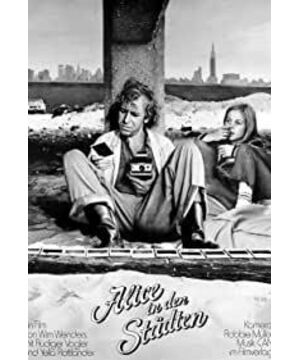In late autumn, a particularly cool tone emerges from the window, as if all the colors are withering, and the city gradually turns gray, becoming more and more hidden in the mist and autumn wind. A sensitive and fragile creature like human beings can most dilute the joy of this scene, let the depression and anxiety in the heart crawl out, and enjoy this cold atmosphere. A black and white movie at this point can calm these worries and keep you from continuing to fall.
"Alice in the City" is actually not as relaxed and splendid as its name suggests, nor is it a travel adventure between a literary boring man and a little familiar loli, it is just two people sitting on trains, planes, ships, hanging trains Wandering aimlessly in the city, each other has a fantasy destination in their hearts, and gradually releases their loneliness, confusion and sadness in the icy buildings and on the long road...
Wenders has never been a delightful director, and despite the film's wonderful name, the city isn't a wonderland, and this Alice can't be magic. Because it is never stable, it is destined to be sad.
Lost Polaroid
The 31-year-old male protagonist's long American work trip is coming to an end. The disgusted radio, muttering to himself, sleepless motels, deserted neighborhoods, and unfamiliar towns all make him feel bored and exhausted. Being able to record these clips without emotion with a Polaroid, but unable to describe it, this charming capital on the other side of the ocean has become lifeless in his eyes. The work could not go on, life was stagnant, and the male protagonist at this time had to return to Germany to renovate. We can get a glimpse of what this man used to be in the first 20 minutes of footage. He has come and gone with many countries and regions, making a living with footage and words. After repeating this for a few years, he seems to have come to a tired period in his life, and the film has since Start.
"Photos are always different from what they see in real life, and the unbearable things disappear from above." It is precisely after enduring too many unbearable things that the photographer will slowly wither and collapse. Put a little girl next to a boring man who has lost his direction in life, how will the story unfold? Routines like mature man + Lolita / Shota seem to be unable to escape the categories of healing, comedy, cuteness, and sadness later on. "Gift" includes "Grand Central Station" and so on, but this one has a little bit of everything, but nothing at all, and Wenders did it.
His shots are cold and quiet. When you watch the performance of the man and girl in front of you, you seem to be standing next to them, without deliberate surprises and waves, without fancy stories and interpretations. This is the most appropriate rhythm for an audience who is about to enter 30 and whose life is no longer a big deal. The male protagonist has long hair, a shoulder bag, flared trousers, a girl's jacket, jeans and a plaid shirt. The two walk side by side and chat next to each other so casually, letting the transport take them through the cities without rushing. The bright sun shone on their languid hair, the wheel of life suddenly stopped, and they simply leaned against each other and lay on their stomachs, as if waiting for something.
Who is lonelier than whom? Who is freer than whom?
During their journey through the city, the protagonists alternately stop at hotels, restaurants, and vehicles, walking, sitting, watching, brief exchanges and long silences. Whether it's New York, Amsterdam, or Germany's Wuppertal, cities serve as less endearing backdrops. Two people who don't know each other and hide their loneliness in each other can't see the cuteness of the city, they go from one place to another just because of some superficial driving force, it is helpless and at a loss. I couldn't feel the joy from their conversational expressions. Even when the two took funny selfies and tacitly approached each other, they just covered their confusion with a momentary smile. The little girl should have expressed her heart and thoughts in a simple and clear way, but the little girl in the film is extremely stable. She is silent, pondering, and showing some anxiety under Wenders' camera from time to time. The situation of the male protagonist can't make him truly happy, and he can't hope that this encounter will bring him a new change - I can't see that kind of warm healing, this is not a soft and aphrodisiac Japanese drama, nor is it a pompous and twisted Korean drama . But that's what made me love the pace of the film even more. If you want to think more about and criticize life and further communicate with the city, silence and sadness are the best ways.
Are they lonely? Girls are "abandoned" by their mothers, and men are abandoned by life, and they all stagnate immediately. Unfamiliar circumstances and a distressed economy do not allow for too much joy. They were forced to "move" up, and when they crossed the city streets, the dashingness of the two was only for a moment, but they could also see what a dazzling light of freedom.
Without direction, it is the best way for people to regain their true freedom. They sat and chatted casually in the restaurant, complaining to each other, as if they were not worried about the direction of life at all, without any entanglement of longing and fantasy, the present is the present, not the erratic future. The camera wandered on the faces of the two for a long time, focusing on their expressions and observing their subtle changes. The pictures that flashed outside the car windows were not given the role of viewing, but were used to modify their mood. When everything seems to be lost, the small gains will make people stop and appreciate, and it is worth remembering. New York is still full of traffic. The male protagonist saw his next sad reminder from the observation telescope on the Empire State Building. He jumped off the sightseeing boat in the city of Amsterdam and ended the boring tour ahead of schedule. He sat on the Wubota Er's suspended train, surreal traversing the quiet city... This may be the only time when we are reminiscent of the title of "Alice in the City", even when we take this novel experience, The protagonist is still dull and silent, and the scenery has nothing to do with him. It shows the original face of the city bluntly, does not choose the exquisitely conceived and gorgeous angles, and gives the viewing experience without modification. This kind of slow and real light and shadow, combined with the depressed face of the protagonist, has been repeated in Wenders' films.
The hanging train in Wubotar in the film is refreshing, and it is also the birthplace of aspirin. For the protagonists, this city can temporarily heal the pain, but they quickly hit the road again, and the future is still not so good. , but this encounter is also like an aspirin, which relieves each other's pain, but cannot cure the pain of each other's life.
View more about Alice in the Cities reviews










